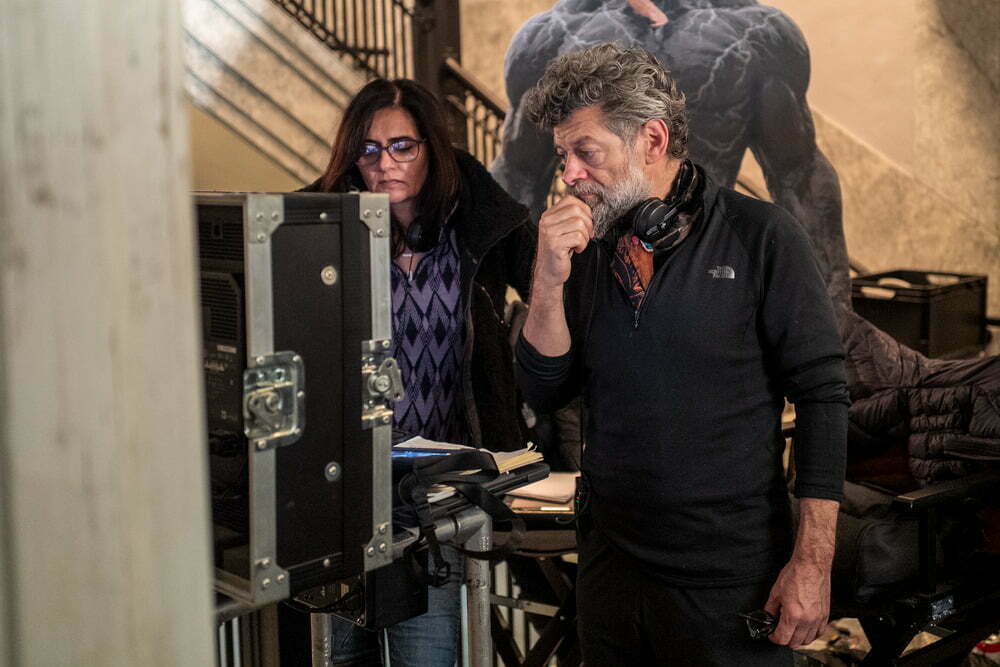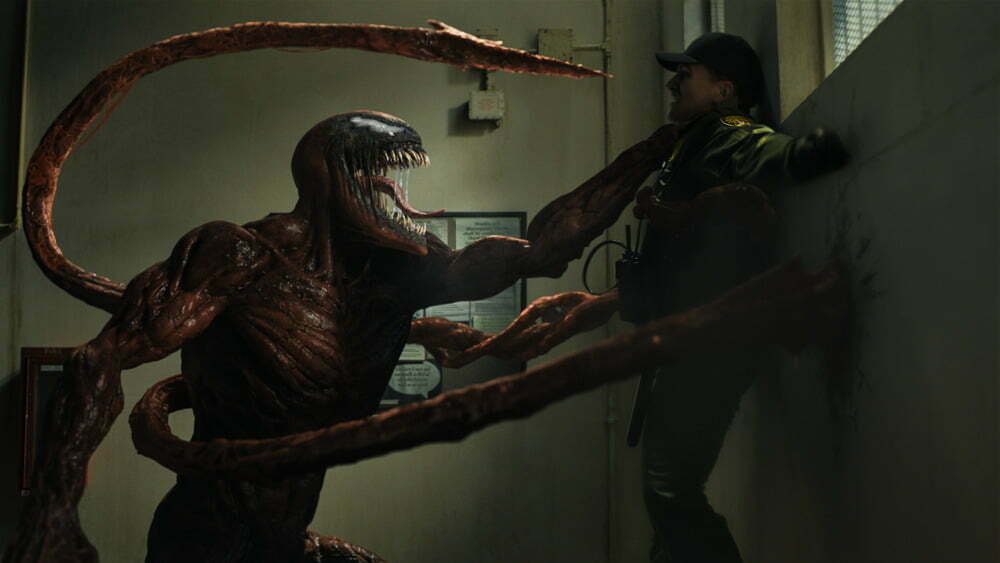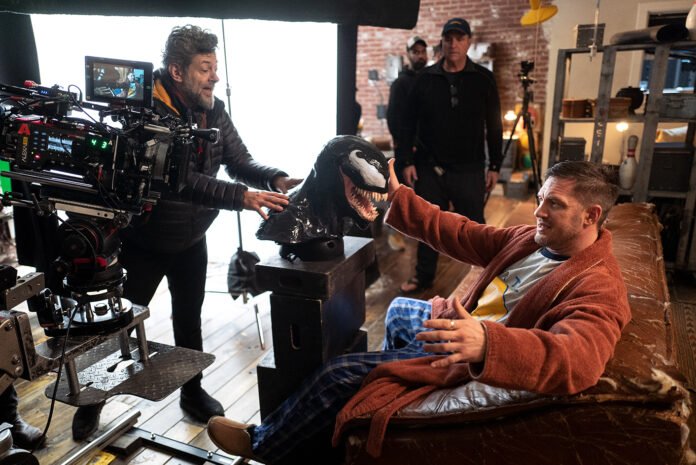Andy Serkis is one of the world’s best-known champions of film characters that blend CG with actors’ performances. Through his work in Lord of the Rings, Planet of the Apes, and Star Wars, as well as his performance capture studio Imaginarium, he has pushed the boundaries of what is possible as he turned in performances that many observers deemed Oscar®-worthy.
Serkis’s experience with CG characters came through on the film set. “I’ve spent a considerable amount of my life playing a character with two sides to his personality,” says Serkis. “I knew that this film would be about how to free up Tom to imagine Venom’s presence. We knew it would not be helpful for him to act opposite a man in a suit, because Venom is a symbiote, coming out of him.”

That is why, despite his many years of acting in performance capture, Serkis chose to animate Venom and Carnage with a more traditional CG animation approach. “We wanted to give Tom the freedom in his process to give the performance he wanted.” He and his team did, however, find ways to apply what he has learned from performance capture to this film. “We used it as a tool to find the physicality of the characters,” he says.

For example, Spencer Cook, who oversaw the animation, says that footage of Hardy performing as Venom would inspire his team’s work. “That gives us some clues and indications of what we would want to take from Tom’s performance to put into Venom,” Cook explains. “We take those ideas and apply them to the Venom version – it’s an artistic interpretation of what Tom is doing.”

There’s one simple reason why they keep going back to Hardy. “Venom is Tom,” says Sheena Duggal, the film’s visual effects supervisor. “Ultimately, everything that we do is built on his incredible performance.”
The character of Venom had been well-designed for the first film, but Carnage would need to be drawn from scratch. “Venom is like a quarterback or a rugby player – very heavy, grounded, a Neanderthal physicality, a heavyweight, big shoulders, very, very, very strong,” says Serkis. “We wanted Carnage to be the opposite of that. He’s a shapeshifter, asymmetrical, reflecting Cletus Kasady’s personality. His tendrils are finer and thinner, and can weaponize in different ways. He can change his molecular structure to become anything, any shape, even turn to mist.”

“The place we started, of course, is the comic books,” says Duggal. “From there, we explored anatomy, we explored materials, what the character’s made of, how it reflects light, what color it is, how it moves and performs, what does the full character look like versus what does a tentacle look like – and how do we bring them all together and put everything into a cohesive world?”
“Unlike Venom, Carnage didn’t necessarily have to be bipedal; he can move his tendrils in different ways,” says Serkis. “I worked with a lot of dancers at the Imaginarium studio to find interesting ways of moving that character – as if we were taking Venom’s energy and displacing it and moving in really interesting, more psychologically driven, twisted ways. It was great to have that opportunity to work with performance capture to form a basis, to find a physical vocabulary for the way Carnage would be.”
“His arms and legs have the same priority as his other tentacles. He’s like the Vitruvian Man,” says Duggal. “Ultimately it’s like fighting a creature who is made of barbed wire and like a bramble bush – he’s so vicious and weaponized and powerful and dangerous. Even if he just swipes you with a tentacle, he’s all covered in razors and barbs, you’re just going to stick to him and be torn to shreds.”

“One of the ideas we had for Carnage was that he would evolve throughout the film and grow his own weapons,” Duggal continues. “As he becomes more and more powerful, he propagates more and more weapons, more barbed and dangerous, and his human form becomes less and less apparent. He can grow a spear from his spine, then pull it out and use it like a javelin, and it just grows back. He can grow other weapons, or eject them as projectiles.”
As he did on the first film, Hardy found that his best performance came from pre-recording Venom’s lines, which the sound team would then feed into his ear for Hardy to act against. “Tom’s process is driven mostly by audio,” says Serkis. “He builds a whole sound radio play before every scene.”
“After rehearsing a scene, Tom would go off into a corner with a sound recorder and lay down a Venom track, which the sound guys would quickly cut into shape,” Serkis explains. “Then, we’d fit Tom with an earpiece, an ‘earwig,’ with the sound guys feeding Venom’s voice into his ear. That way, Tom can get his timing, he’s able to act against Venom, and he creates a physical presence for the character wherever he chooses to place his eyeline.”
“I have a radio transmitter that can play audio in and out, from up to 200 yards away,” says Patrick Anderson, the production’s playback sound technician — the sound engineer specifically responsible for the playback of Venom – who Hardy calls his “partner” for the scenes in which he acts opposite Venom. “I can feed him the Venom dialogue – and Tom will give me feedback, like ‘Take an extra beat before you feed me this line,’ or ‘Interrupt me with this line, mess with me’ – because Eddie can’t control the alien living inside of him. Having the cues set up individually, line by line, we’re able to make it free-flowing and chaotic, and a little more kinetic for Tom.”
Venom’s voice is enhanced by movie magic, but not by much – according to Anderson, Hardy’s performance brings the character most of the way there. “It’s pretty phenomenal how much of the character he can inherently give me,” says Anderson. “I’m just polishing the last 10% with a couple effects of my own – a little bit of pitch shifting to put it in that low monster register, some modulation to make it spacey sounding.”

Bringing the characters to the screen also required a close collaboration with the film’s legendary director of photography, the three-time Oscar® winner Robert Richardson. “Venom needs to be lit in a specific way, or you can’t see the articulation of his anatomy,” says Duggal. “We found the best way to articulate the form of Venom is to use spectacular highlights that reflect off of his slimy surface. On set, we had a standalone bust that the stand-in could wear on his head and shoulders, and a bit of Venom material on a ball that we could hold in place of tentacles. With these, when Bob was lighting the shot, he could have a physical reference of what Venom would ultimately look like in the visual effects shot.”
Another way the filmmakers were able to get a picture of how Venom or Carnage might look in a scene was with AR technology. “We had an app that allowed us to put Venom or Carnage on any surface in the set environment, and then move around and see how it looked,” says Duggal.
Shriek would also require a visual effects enhancement. “In order to achieve the desired effect, we relied on two ingredients – the visual representation of the scream, using Cymatic patterns – Cymatics is the study of visible sound and vibration – and its interaction with the environment. “The visual representation for how it interacted with the environment ranged from replacing live-action props to make them fly around a cell room, to fully replacing Shriek digitally so we could make her cheeks, hair, and clothes react.”
Starring Tom Hardy, Michelle Williams, Naomie Harris, Reid Scott, Stephen Graham, and Woody Harrelson. Directed by Andy Serkis. Produced by Avi Arad, Matt Tolmach, Amy Pascal, Kelly Marcel, Tom Hardy, and Hutch Parker. Screenplay by Kelly Marcel. Story by Tom Hardy & Kelly Marcel. Based on the MARVEL Comics. Executive Producers are Barry Waldman, Jonathan Cavendish, and Ruben Fleischer. Director of Photography is Robert Richardson, ASC. Production Designer is Oliver Scholl. Editors are Maryann Brandon, ACE and Stan Salfas, ACE. Visual Effects Supervisor is Sheena Duggal. Costume Designer is Joanna Eatwell. Music by Marco Beltrami.
Venom: Let There Be Carnage is rated PG-13 by the Motion Picture Association for the following reasons: intense sequences of violence and action, some language, disturbing material and suggestive references.
The film will be released in theaters nationwide on October 1st, 2021.
Discover more from SNAP TASTE
Subscribe to get the latest posts sent to your email.



